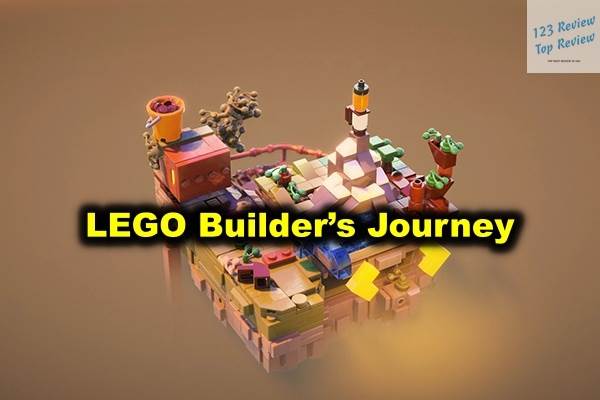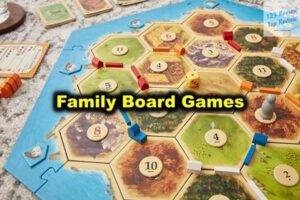In this article, 123 Review covers the game’s unique gameplay mechanics, the significance of its parent-child relationship theme, and its innovative use of advanced graphics like ray tracing. It also compares the game to other LEGO titles and puzzle games, discusses its reception, and considers potential future directions for LEGO games. Whether you’re a LEGO fan or a puzzle game enthusiast, this article provides insights into what makes “LEGO Builder’s Journey” a memorable experience.
Overview of LEGO Builder’s Journey
General Gameplay Mechanics
“LEGO Builder’s Journey” represents a unique entry in the LEGO gaming universe, standing apart from its predecessors by focusing on puzzle-solving and creativity rather than action-packed adventure or open-world exploration. Developed by Light Brick Studio, this game invites players into a meditative experience where the simple act of placing LEGO bricks becomes a deeply engaging and emotionally resonant journey.

At its core, LEGO Builder’s Journey is a puzzle game that challenges players to manipulate LEGO bricks to solve various puzzles. These puzzles are typically structured around guiding characters—represented as minimalist LEGO figures—through levels by constructing paths, bridges, or other structures using a limited set of bricks. The game’s controls are intentionally simple, allowing players to pick up, rotate, and place bricks with ease. On PC, this is accomplished through a point-and-click interface, while on mobile devices, intuitive touch controls allow for smooth interaction.
The gameplay mechanics are designed to be accessible to players of all ages. The simplicity of picking up and placing bricks belies the depth of the puzzles, which require careful consideration of spatial relationships and the properties of each brick. As players progress, they encounter increasingly complex challenges that demand creative thinking and a deepening understanding of the game’s mechanics.
Level Design and Puzzles
The level design in LEGO Builder’s Journey is one of its most commendable aspects, showcasing a masterful blend of simplicity and complexity. Each level is a self-contained puzzle that offers a distinct challenge, with no two levels feeling exactly alike. The game’s minimalist design ensures that players are never overwhelmed by unnecessary details, allowing them to focus on the core puzzle mechanics.
Early levels serve as an introduction to the game’s basic mechanics, guiding players through simple tasks such as placing bricks to create a path or bridge a gap. These introductory levels are designed to be intuitive, with clear visual cues that help players understand the game’s logic. However, as players advance, the puzzles become more intricate, introducing new elements and challenges that require more thoughtful planning and execution.
One of the game’s strengths is its ability to introduce new mechanics gradually, allowing players to learn through experience rather than through tutorials. For example, players might start with basic construction tasks, but soon they must navigate environmental hazards, manipulate timing-based mechanisms, or even deconstruct their previous work to find a solution. This approach keeps the gameplay fresh and engaging, as players are constantly learning and adapting to new challenges.
The puzzles are designed to encourage creativity and experimentation. While there is often a “correct” solution to each puzzle, the game frequently allows for multiple approaches, giving players the freedom to solve challenges in their own way. This open-ended design fosters a sense of discovery and satisfaction, as players feel a genuine sense of accomplishment when they complete a particularly tricky puzzle.
Unique Features of the Game
LEGO Builder’s Journey distinguishes itself from other games in the LEGO franchise through its unique approach to storytelling and gameplay. Unlike the more action-oriented LEGO titles, Builder’s Journey is a quiet, contemplative experience that uses the medium of LEGO bricks to explore deeper themes of connection, creativity, and growth.
One of the most notable features of LEGO Builder’s Journey is its emphasis on environmental storytelling. The game tells a wordless narrative centered around the relationship between a parent and their child. This story unfolds organically through the gameplay, with each puzzle and level serving as a metaphor for the characters’ emotional journey. The absence of dialogue allows the story to resonate on a universal level, with players interpreting the narrative through their interactions with the game world.
The game also introduces a “Creative Mode,” which offers players the opportunity to build without the constraints of the puzzle-based levels. This mode is a celebration of the core LEGO experience—unrestricted creativity. In Creative Mode, players are free to experiment with different brick combinations, build whatever comes to mind, and explore the endless possibilities that LEGO bricks offer. This mode adds significant replay value to the game, as players can return to it time and again to create new structures and experiment with different ideas.
Another unique aspect of LEGO Builder’s Journey is its approach to difficulty. While the puzzles can be challenging, the game never feels punitive or frustrating. Instead, the difficulty curve is carefully calibrated to encourage players to think critically and explore different solutions without feeling pressured. The game’s design philosophy emphasizes the joy of discovery and the satisfaction of creative problem-solving, making it accessible to both casual players and puzzle enthusiasts.
Visual and Audio Experience
Graphics Quality and Style
Visually, LEGO Builder’s Journey is nothing short of a masterpiece. The game combines the familiar aesthetic of LEGO bricks with cutting-edge graphics technology to create a world that feels both nostalgic and incredibly detailed. Each brick in the game is rendered with stunning fidelity, capturing the texture, color, and sheen of real LEGO pieces. The attention to detail is remarkable, with even the smallest elements—such as the studs on top of the bricks—meticulously crafted.
The game’s art style is minimalist yet evocative, with soft, warm color palettes that create a serene and inviting atmosphere. The environments are designed to be simple and clean, allowing the focus to remain on the LEGO constructions and the puzzles at hand. Despite the simplicity of the design, the game world feels alive and dynamic, with subtle animations and environmental effects that enhance the sense of immersion.
One of the standout features of LEGO Builder’s Journey is its use of depth of field and other visual effects to create a sense of scale and perspective. The camera work is particularly impressive, with smooth transitions and zooms that highlight the intricate details of the LEGO constructions and the puzzle elements. These camera movements not only enhance the visual appeal of the game but also serve to guide the player’s attention to important aspects of the puzzles.
Use of Ray Tracing and DLSS
LEGO Builder’s Journey is one of the few puzzle games that leverages advanced graphics technologies such as ray tracing and DLSS (Deep Learning Super Sampling). These technologies are typically associated with high-end gaming experiences, but their implementation in Builder’s Journey elevates the game’s visuals to a whole new level.
Ray tracing is used to enhance the game’s lighting, reflections, and shadows, making the LEGO bricks appear even more realistic. The effect is particularly striking in levels with complex lighting scenarios, where the interplay of light and shadow creates a sense of depth and realism that is rarely seen in puzzle games. Reflections on glossy surfaces and the way light interacts with the translucent bricks add to the overall visual fidelity, making the game a true showcase of what modern graphics technology can achieve.
DLSS, on the other hand, allows the game to maintain high performance while delivering sharp and detailed visuals. This technology uses AI to upscale lower-resolution images in real-time, resulting in a crisp and smooth visual experience even on hardware that might not be able to handle native 4K rendering. The combination of ray tracing and DLSS ensures that LEGO Builder’s Journey looks stunning while still running smoothly, providing an optimal experience for players with compatible hardware.
Soundtrack and Audio Design
The audio experience in LEGO Builder’s Journey is as carefully crafted as its visuals, contributing significantly to the game’s overall atmosphere and emotional impact. The soundtrack, composed by Henrik Lindstrand, is a blend of soothing, ambient music that perfectly complements the game’s visual style and narrative themes. The music is subtle, often playing in the background, but it plays a crucial role in setting the tone for each level and guiding the player’s emotional journey.
The soundtrack evolves with the gameplay, shifting in mood and intensity to match the player’s progress through the game. In moments of quiet reflection, the music is soft and contemplative, creating a sense of peace and introspection. During more challenging puzzles, the music becomes more dynamic, heightening the tension and emphasizing the importance of the task at hand. This dynamic use of music helps to create a cohesive and immersive experience, where the audio and visual elements work in harmony to tell the game’s story.
In addition to the music, the sound design of LEGO Builder’s Journey is equally impressive. The sounds of clicking bricks, gentle environmental noises, and the subtle feedback from the game’s interface all contribute to the overall sense of immersion. The sound effects are crisp and clear, with each action in the game producing a satisfying and tactile response. Whether it’s the sound of a brick snapping into place or the soft rustling of leaves in the background, the audio design enhances the player’s connection to the game world and the characters within it.
Themes and Emotional Impact
Parent-Child Relationship Theme
One of the most poignant aspects of LEGO Builder’s Journey is its exploration of the parent-child relationship. The game tells a wordless story about the bond between a parent and their child, using the medium of LEGO bricks as a metaphor for connection, growth, and the passage of time. This theme is woven into every aspect of the game, from the puzzles and level design to the visual and audio elements.
The parent-child relationship is portrayed with a depth and subtlety that is rare in video games. The characters are represented as simple LEGO figures, yet their interactions are filled with emotion and meaning. The game uses the act of building as a metaphor for the relationship, with the parent guiding and supporting the child through the challenges of each level. As the game progresses, the roles of the parent and child evolve, reflecting the changing dynamics of their relationship.
The absence of dialogue in LEGO Builder’s Journey allows the story to be universal and relatable. The emotions are conveyed through the gameplay and the interactions between the characters, making the narrative accessible to players of all ages and backgrounds. This approach also allows players to interpret the story in their own way, finding personal meaning in the journey of the characters.
Importance of Creativity and Play
Creativity and play are central themes in LEGO Builder’s Journey, reflecting the core philosophy of the LEGO brand. The game encourages players to think creatively and to find joy in the act of building and problem-solving. This emphasis on creativity is evident not only in the puzzle-based levels but also in the Creative Mode, where players are free to build without constraints.
In LEGO Builder’s Journey, creativity is not just a means to an end; it is the essence of the gameplay. The puzzles are designed to encourage players to explore different solutions, experiment with new ideas, and think outside the box. This open-ended approach to puzzle-solving fosters a sense of playfulness and discovery, making each level feel like a new opportunity to express creativity.
The game also highlights the importance of play as a means of learning and connection. Through the simple act of building with LEGO bricks, the characters in the game grow closer, and the player is reminded of the joy that comes from creativity and shared experiences. This theme is particularly powerful in the context of the parent-child relationship, where play becomes a way for the characters to bond and communicate without words.
Emotional Resonance in Gameplay
LEGO Builder’s Journey is a game that resonates emotionally with players, thanks to its combination of heartfelt storytelling, engaging gameplay, and beautiful presentation. The puzzles are designed not only to challenge the player’s intellect but also to evoke a sense of wonder, satisfaction, and emotional connection. Each completed level brings a sense of accomplishment and progress in the narrative, reinforcing the emotional journey of the characters.
The game’s emotional impact is enhanced by its use of visual and audio storytelling. The simple yet expressive animations of the LEGO characters, the evocative music, and the carefully crafted environments all work together to create moments of genuine emotional resonance. Whether it’s the joy of solving a particularly challenging puzzle, the bittersweetness of a moment of separation, or the warmth of a reunion, LEGO Builder’s Journey is filled with moments that leave a lasting impression on the player.
Comparison with Other LEGO Games
Differences from Traditional LEGO Titles
LEGO Builder’s Journey stands out from traditional LEGO games in several significant ways. Unlike the action-adventure format of games like LEGO Star Wars, LEGO Marvel Super Heroes, or LEGO Harry Potter, Builder’s Journey takes a more introspective and puzzle-focused approach. The game eschews the fast-paced combat, collectibles, and sprawling open worlds of its predecessors in favor of a slower, more meditative experience.
This shift in focus is reflected in the game’s pacing and tone. LEGO Builder’s Journey is a game that invites players to take their time, to think carefully about each move, and to appreciate the beauty of the world around them. The game’s minimalist design, lack of dialogue, and emphasis on environmental storytelling create a contemplative atmosphere that is quite different from the lighthearted humor and action-packed sequences of traditional LEGO titles.
Another key difference is the game’s approach to difficulty and challenge. While traditional LEGO games are known for their accessible gameplay and family-friendly design, LEGO Builder’s Journey offers a more challenging experience that requires players to think creatively and solve complex puzzles. The game’s difficulty curve is carefully balanced, ensuring that players are always engaged without feeling overwhelmed.
Innovations in Gameplay and Storytelling
LEGO Builder’s Journey introduces several innovations in both gameplay and storytelling that set it apart from other LEGO games. One of the most notable innovations is the game’s use of environmental storytelling, where the narrative is conveyed through the player’s interactions with the world rather than through dialogue or cutscenes. This approach allows for a more immersive and emotionally resonant experience, as players are invited to interpret the story and find personal meaning in the journey of the characters.
In terms of gameplay, LEGO Builder’s Journey focuses on creative problem-solving rather than linear, objective-based gameplay. The game’s open-ended puzzles encourage players to experiment with different solutions and to think critically about the relationships between the bricks and the environment. This emphasis on creativity is a refreshing change from the more formulaic gameplay of traditional LEGO titles and adds a layer of depth and replayability to the game.
The game also innovates in its use of advanced graphics technologies, such as ray tracing and DLSS, to enhance the visual experience. These technologies are typically associated with high-end gaming experiences, but their implementation in a puzzle game like Builder’s Journey is a bold and successful experiment that elevates the game to a new level of visual fidelity.
Similarities with Other Puzzle Games
While LEGO Builder’s Journey is a departure from traditional LEGO games, it shares similarities with other puzzle games like Monument Valley, The Room, and Lumino City. Like these games, Builder’s Journey features visually striking environments, clever puzzles, and a strong emphasis on atmosphere and mood. The game’s isometric perspective, minimalist design, and focus on creative problem-solving are all reminiscent of the puzzle genre’s best offerings.
However, LEGO Builder’s Journey distinguishes itself from other puzzle games through its use of the LEGO brand’s unique charm and its emphasis on storytelling through gameplay. The game’s use of LEGO bricks as both a gameplay mechanic and a narrative device is a clever twist that adds a layer of nostalgia and familiarity to the experience. This combination of innovative gameplay, emotional storytelling, and the iconic LEGO aesthetic sets Builder’s Journey apart from its peers in the puzzle genre.
User Experience and Accessibility
Ease of Controls and Interface
LEGO Builder’s Journey is designed with accessibility in mind, offering a simple and intuitive control scheme that makes it easy for players of all ages to pick up and play. The game’s point-and-click interface on PC and the touch controls on mobile devices are responsive and user-friendly, allowing players to focus on the puzzles without being bogged down by complicated mechanics.
The controls are minimalistic, with only a few actions required to interact with the game world. Players can pick up, rotate, and place bricks with just a few clicks or taps, making the game easy to learn and play. The simplicity of the controls is one of the game’s strengths, as it ensures that the gameplay remains accessible to a wide audience, including younger players and those who may not be familiar with video games.
The game’s interface is clean and unobtrusive, with only the essential elements displayed on the screen. This minimalist design choice keeps the focus on the gameplay and the story, creating a more immersive experience. The interface is also designed to be intuitive, with clear visual cues and prompts that guide the player without overwhelming them with information.
Availability on Different Platforms
LEGO Builder’s Journey is available on a variety of platforms, including PC, Nintendo Switch, and iOS devices. The game’s controls and interface have been optimized for each platform, ensuring a smooth and enjoyable experience regardless of how players choose to play. The availability on multiple platforms makes the game accessible to a broad audience, allowing players to enjoy the game on their preferred devices.
The game performs well across all platforms, with the graphics and audio quality adapted to suit the capabilities of each device. On PC, players can take advantage of advanced graphics features like ray tracing and DLSS, while the mobile version offers a streamlined experience that retains the game’s visual and emotional impact. The Nintendo Switch version strikes a balance between the two, offering portability without sacrificing the game’s visual fidelity.
Target Audience
LEGO Builder’s Journey is a game that appeals to a wide range of players, from young children to adults. The game’s simple controls and charming visuals make it accessible to younger players, while the deeper emotional themes and challenging puzzles offer something for older players as well. The game’s emphasis on creativity and play also makes it a great choice for families, as it encourages collaborative problem-solving and imaginative thinking.
The game’s themes of connection, creativity, and emotional growth resonate with players of all ages, making LEGO Builder’s Journey a universally appealing experience. Whether you’re a fan of LEGO, a puzzle enthusiast, or simply someone looking for a unique and emotionally engaging game, LEGO Builder’s Journey has something to offer.
Critical Reception and Reviews
Aggregate Scores from Review Platforms
LEGO Builder’s Journey has received generally positive reviews from both critics and players, earning solid scores on review aggregator sites like Metacritic, OpenCritic, and others. The game has been praised for its beautiful visuals, innovative gameplay, and emotional storytelling, with many reviewers highlighting it as a standout title in the puzzle genre.
On Metacritic, LEGO Builder’s Journey has achieved an aggregate score in the mid-70s to mid-80s, depending on the platform, indicating a favorable reception. Similarly, OpenCritic’s consensus reflects the game’s strengths, with many reviewers noting its unique approach to puzzle-solving and storytelling as key factors in their positive assessments. The game’s visual and audio design, as well as its use of advanced graphics technologies, have also been frequently mentioned as highlights.
Highlights from Critic Reviews
Critics have lauded LEGO Builder’s Journey for its ability to blend creativity, emotion, and technical excellence into a cohesive and engaging experience. Many reviews emphasize the game’s stunning visuals, particularly its use of ray tracing and DLSS, which elevate the LEGO bricks to a level of realism and detail rarely seen in puzzle games. The game’s minimalist art style and atmospheric lighting have also been praised for creating a visually striking world that draws players in.
The storytelling in LEGO Builder’s Journey has been another focal point of praise, with reviewers appreciating the game’s subtle and wordless narrative. The parent-child relationship theme, conveyed through the gameplay and visual cues, has resonated with many players and critics alike, adding an emotional depth to the experience that sets the game apart from other titles in the LEGO franchise.
The innovative gameplay, which emphasizes creative problem-solving and open-ended puzzles, has also been well-received. Critics have noted that the game’s puzzles are thoughtfully designed, challenging players to think critically and experiment with different solutions. The inclusion of Creative Mode has been highlighted as a valuable addition, offering players the freedom to explore their creativity without the constraints of the main game.
Common Criticisms and Praise
While LEGO Builder’s Journey has garnered widespread praise, it has also faced some criticisms, particularly regarding its length and replayability. Some players have noted that the game is relatively short, with a playtime of only a few hours. This has led to some disappointment among those who were hoping for a longer experience. Additionally, while the puzzles are well-designed, a few critics have mentioned that the game can feel repetitive in the later levels, as the mechanics remain largely the same throughout.
However, these criticisms are often outweighed by the game’s strengths. The brevity of LEGO Builder’s Journey is seen by many as a positive, allowing the game to deliver a concise and focused experience without unnecessary padding. The emotional impact, beautiful visuals, and innovative gameplay are consistently praised, with many players finding the game’s short length to be a refreshing change from longer, more drawn-out titles.
Future Directions for LEGO Games
Potential for Sequels or New Titles
The success of LEGO Builder’s Journey has opened the door for potential sequels or new titles that build on the game’s unique approach to puzzle-solving and storytelling. A sequel could expand on the mechanics introduced in Builder’s Journey, offering new types of puzzles, environments, and themes to explore. The parent-child relationship theme could be further developed, or the game could explore different types of relationships and emotions.
Alternatively, Light Brick Studio could develop new LEGO games that focus on other aspects of the LEGO brand, such as construction, creativity, or exploration. These games could retain the innovative gameplay and emotional storytelling that made Builder’s Journey a success, while introducing new mechanics and features to keep the experience fresh and engaging.
Community Feedback and Its Influence
Community feedback has been an important factor in the development and reception of LEGO Builder’s Journey, and it will likely continue to play a role in shaping future LEGO games. Players have responded positively to the game’s focus on creativity, emotional storytelling, and visual excellence, and this feedback could influence the direction of future titles. The desire for more content and longer playtime could lead to the development of expansions, updates, or sequels that build on the foundation laid by Builder’s Journey.
Additionally, the community’s appreciation for the game’s Creative Mode could inspire the inclusion of similar features in future LEGO games. By offering players more opportunities to express their creativity and explore the possibilities of LEGO bricks, future titles could further enhance the connection between the digital and physical LEGO experiences.
Trends in Puzzle Game Design
LEGO Builder’s Journey is part of a broader trend in puzzle game design that emphasizes creativity, atmosphere, and emotional storytelling. As more games in the genre explore these elements, we can expect to see continued innovation and experimentation in puzzle game design. Future LEGO games could push the boundaries of what’s possible in a puzzle game, using new technologies like ray tracing, AI, and procedural generation to create even more immersive and dynamic experiences.
The success of LEGO Builder’s Journey also suggests a growing interest in games that offer more than just entertainment, but also emotional resonance and meaningful themes. As the gaming industry continues to evolve, we may see more titles that, like Builder’s Journey, use gameplay as a means of exploring complex emotions, relationships, and ideas.
In conclusion, LEGO Builder’s Journey is a standout title that offers a unique blend of creative puzzle-solving, emotional storytelling, and stunning visuals. Its success paves the way for future innovations in both LEGO games and the puzzle genre as a whole. Whether you’re a fan of LEGO or simply enjoy well-crafted puzzle games, Builder’s Journey is a game that’s well worth experiencing.





